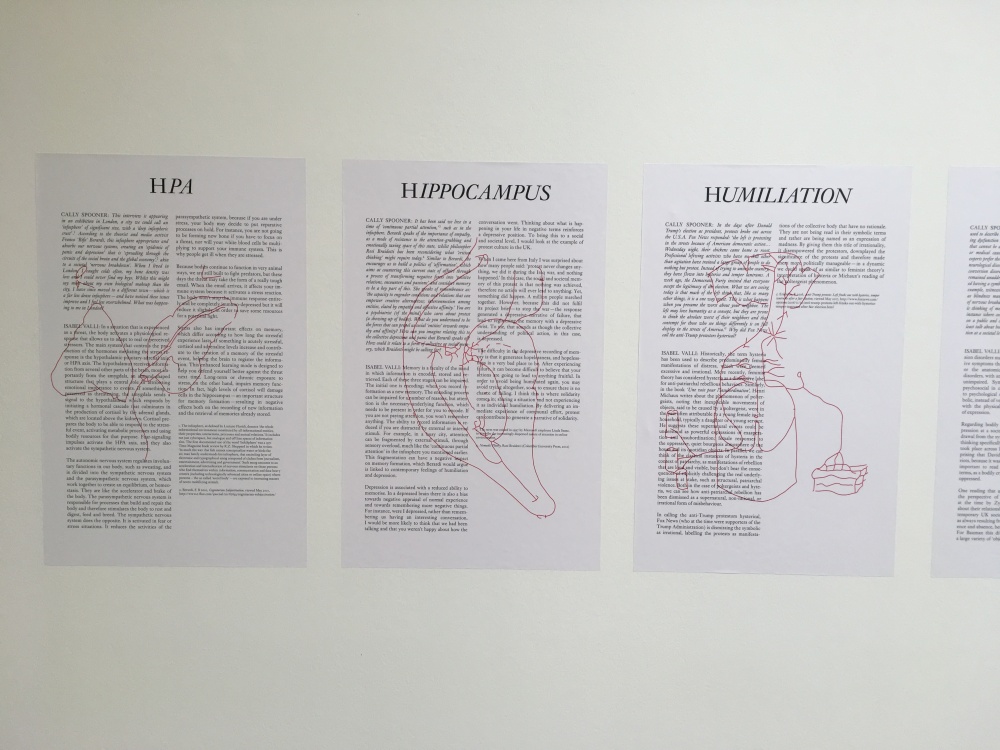The Whitechapel Gallery in London is currently showing a small solo presentation of the young British born, Athens based female artist Cally Spooner (1983), who works in many different media and disciplines. She is currently the gallery’s writer in residence and uses text, sound and choreography to stage absurdist replays of the political, ecenomic and media rhetoric of our time. Two of her works are presented in the rooms of the gallery: ‘Soundtrack for a troubled time’ and ‘Notes on Humiliation’.
Unfamiliar with her work, I visited her presentation having no idea what to expect, especially since there was not much in the rooms of her presentation to be seen. The first thing that strikes you about the presentation, is the eery soundtrack playing in the background, in which a man seems to be counting. This sound work is a collaboration with performer Michelangelo Miccolis, with whom she often works together, she as an artist in his curatorial projects and he as a producer to her live productions. The work ‘Soundtrack for a troubled time’ consists of two channels. In the right channel, Miccolis is counting to ten in his native language as continuously buckets of water are being poured over him, leaving him shivering. In the left channel a golf club is hitting a ball, producing the sound of a sharp thwack.

The other work on show, ‘Notes on Humiliation’ transcribes extracts from Cally Spooner’s interview with psychiatrist Isabel Valli. The work consists of five sheets of paper with texts on them with drawings of organs in red over them, the fifth one only showing a drawing. The first four sheets have titles: HPA, Hippocampus, Humiliation and Riots. The drawings are human organs that produce the stress hormone cortisol.
Spooner and Valli go into dialogue with eachother to understand the condition of hysteria at a societal level by going into the themes pre-verbal communication, trauma, apocalypse and protest and ask how these conditions can be captured and made visible in 2017. When writing my master thesis in early 2016, I researched the condition of hysteria and how it had been presented throughout art history. Hysteria has been always a condition that was very misunderstood because the medical knowledge wasn’t nearly as developed as today. It was a disease that was thought to be prevalent in women more than men, and some doctors would even go as far as suggesting it was a condition that had its source in the woman’s womb. (Source: Olivier Walusinski, ‘The Girls of La Salpêtrière’, in: J. Bogousslavsky, Hysteria: The Rise of an Enigma, Basel 2014, pp. 65-69) In the third sheet, ‘Humiliation’, this is also said by Valli: ‘Historically, the term hysteria has been used to describe predominantly female manifestations of distress, which were deemed excessive and irrational.’
The dialogue between the two women is of a mixed medical and cultural nature. Spooner for instance asks questions about the ‘infosphere’ in London, where she has lived in the past, and how this might have influenced her health. The two discuss both the medical source of modern day hysteria and try to determine how social factors might have influenced this as well.
What interested me so much from Spooner’s work, is firstly my own interest in (contemporary) art that deals with medical issues. When writing my thesis, I could not seem to find any contemporary artists dealing with hysteria, after which I concluded that this was the case because the affliction had been researched more thoroughly and that the symptoms caused by what was thought to be hysteria are the result of other diseases. So I immediately thought: I definitely should have incorporated this work into my thesis if I had the chance. But despite that, it was still very interesting to see how both an artist and a psychiatrist share their views on modern day hysteria.
Secondly, a very intruiging aspect to these works by Spooner is the fact that at first, there doesn’t seem to be much to see or to take in. But when you have been in the room for a while and then hear the sudden thwack of the golf ball for the first time, it makes you listen more closely to why the man in the other channel is shivering. When first seeing the writings of ‘Notes of Humiliation’, your initial thought might be ‘what are those organs, why did she choose these words as titles, and what do they both have to do with the texts?’ It makes you interested, it makes you curious. The works give you just enough to get your train of thoughts out of the station, and it is a magical ride.